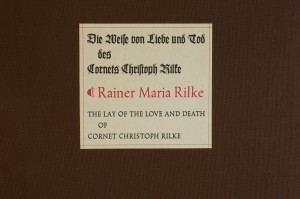 Ever since I read Stephen Mitchell’s translation of the Tao Te Ching at just the right time in a critical juncture of my life, I’ve eagerly sought out anything else he’s done. That made finding a copy of the Arion Press edition of The Lay of the Love and Death of Cornet Christoph Rilke that much more joyful for me. Rilke, Stephen Mitchell, and the fine press treatment: What could be better? Including the Tao mentioned above, I have six trade editions of Mitchell’s and I would buy
Ever since I read Stephen Mitchell’s translation of the Tao Te Ching at just the right time in a critical juncture of my life, I’ve eagerly sought out anything else he’s done. That made finding a copy of the Arion Press edition of The Lay of the Love and Death of Cornet Christoph Rilke that much more joyful for me. Rilke, Stephen Mitchell, and the fine press treatment: What could be better? Including the Tao mentioned above, I have six trade editions of Mitchell’s and I would buy 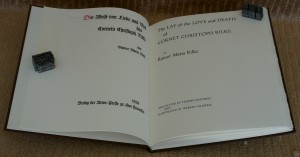 any one of them again if a private press decided to put out a fine edition. His new translation of the Iliad? Yes, please. His version of Whitman’s Song of Myself? Pretty Please! More of his Rilke? Anytime. The Gospel According to Jesus? Bring it! In fact, I think his Iliad would fit in nicely with the wonderful Arion Press Don Quixote translated by Edith Grossman. I’m not knocking the old, classic translations of essential world literature, and I get the whole public domain copyright issue, but it is nice to see a new translation make it through a private press once in a while.
any one of them again if a private press decided to put out a fine edition. His new translation of the Iliad? Yes, please. His version of Whitman’s Song of Myself? Pretty Please! More of his Rilke? Anytime. The Gospel According to Jesus? Bring it! In fact, I think his Iliad would fit in nicely with the wonderful Arion Press Don Quixote translated by Edith Grossman. I’m not knocking the old, classic translations of essential world literature, and I get the whole public domain copyright issue, but it is nice to see a new translation make it through a private press once in a while.
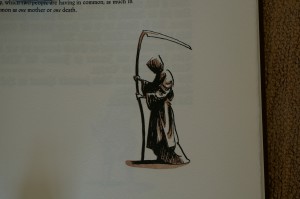 So I love the translator, obviously, but what about Rilke himself? I’ve had a big hole in my reading life for a long time with regards to him. I’m not sure that I’ve really read more than the odd poem or two of his poetry. His Letters to a Young Poet, translated by Stephen Mitchell of course, is sitting on my shelf waiting in to-be-read list limbo. The Lay of the Love and Death of Cornet Christoph Rilke is a wonderful and poignant book about the transition into manhood. In this case, a very short manhood, as can often be the case where aspect of that transition comes in the army in a time of war. The story ends with an old woman crying, mourning her son.
So I love the translator, obviously, but what about Rilke himself? I’ve had a big hole in my reading life for a long time with regards to him. I’m not sure that I’ve really read more than the odd poem or two of his poetry. His Letters to a Young Poet, translated by Stephen Mitchell of course, is sitting on my shelf waiting in to-be-read list limbo. The Lay of the Love and Death of Cornet Christoph Rilke is a wonderful and poignant book about the transition into manhood. In this case, a very short manhood, as can often be the case where aspect of that transition comes in the army in a time of war. The story ends with an old woman crying, mourning her son.
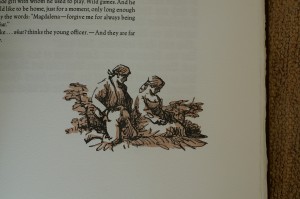 The other aspect of the transition is from maternal love to romantic love. As he rides towards the war and his fate, he reminisces with his comrades about their mothers (“As if there were only one mother…”) and their real or just wished-for sweethearts back home. When he parts from his comrade of the road, our protagonist is given a petal from a rose given to his comrade by his sweetheart. Filled with melancholy, we read
The other aspect of the transition is from maternal love to romantic love. As he rides towards the war and his fate, he reminisces with his comrades about their mothers (“As if there were only one mother…”) and their real or just wished-for sweethearts back home. When he parts from his comrade of the road, our protagonist is given a petal from a rose given to his comrade by his sweetheart. Filled with melancholy, we read
“Then he slips the foreign petal under his tunic. And it drifts up and down on the waves of his heart. Buglecall. He rides to the army, von Langenau. He smiles sadly: he is being protected by a foreign woman.”
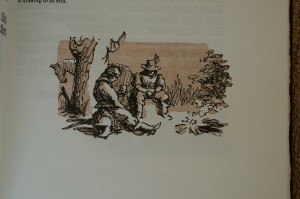 This beautiful and expressive writing continues when our hero bivouacs at a Hungarian castle. Here they have food, rest, real beds,…and ladies. I especially loved these two passages:
This beautiful and expressive writing continues when our hero bivouacs at a Hungarian castle. Here they have food, rest, real beds,…and ladies. I especially loved these two passages:
“You feel the wavebeats pounding through the room, you touch somebody, breathe-in her perfume, you part from her and find her once again, and then, through all the light-filled melodies, dazzled, you sway upon the summer breeze which fills the dresses that warm women wear.”
And
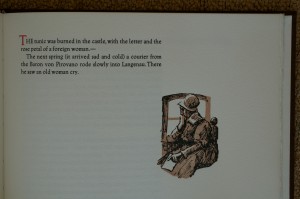 “They have come together so that they can be for each other a new generation.
“They have come together so that they can be for each other a new generation.
They will give each other a hundred new names and will take them all off again, gently, as you would take off an earring.”
So he is initiated into the romantic love of women and now he is ready to die a hero’s death.
In the Translator’s Note, Mitchell says that Rilke found some papers pertaining to his 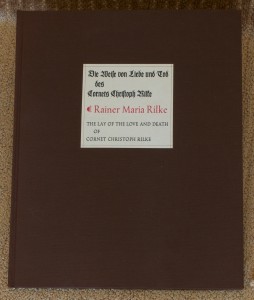 kinsman Christoph, who had been killed 250 years earlier in his first campaign. The book came in a rush. Mitchell notes a letter by the poet describes the stampede of words:
kinsman Christoph, who had been killed 250 years earlier in his first campaign. The book came in a rush. Mitchell notes a letter by the poet describes the stampede of words:
‘Riding, riding, riding…’ I found myself whispering them almost unconsciously. And then I began to write, as in a dream. I wrote all through the night. By dawn the Cornet was finished.
The book was a huge success for Rilke, so much so that Mitchell notes that
“And Rilke, perhaps the greatest poet of this century, the poet who in 1922 wsa granted the supreme achievements of the Duino Elegies and The Sonnets to Orpheus, found himself primarily know and loved for a minor work of his youth.”
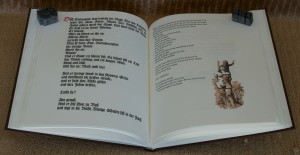 He closes the Translator’s note with the opinion that any romance that war might have once held has been erased by the world wars and weapons of mass destruction:
He closes the Translator’s note with the opinion that any romance that war might have once held has been erased by the world wars and weapons of mass destruction:
After World War II, the romantic experience of war has not been available to us with quite the same deadly innocence. And given the generous, all-embracing nature of the nuclear bomb, it would be more difficult now (at least in Europe and America) for males to have this particular way of acting out their longing for the Eternal Now. What was once only too real is now, we may hope, just an imaginative possibility. We can accept it for what it is, enjoy it, include it within the realm of our sympathies, then let it go serenely, without judgment.
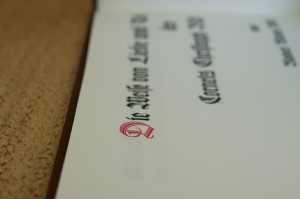 The Arion Press edition was published in 1983 and is a great example of early output from the press. This is a very handsome edition. The Wilhelm Klingspor Schrift and Zierschrift type for the German text on the verso pages seems perfect for the masculinity of the German language and the subject matter. The English on the recto pages is in Trajanus Antiqua and sits well next to the heavier type used for the German. The use of red ink for the initial capitals is a nice touch that I always appreciate in book design. The smell of the T. H. Saunders mouldmade paper is still there 30 years after publishing. Does that wonderful smell ever go away? I hope not.
The Arion Press edition was published in 1983 and is a great example of early output from the press. This is a very handsome edition. The Wilhelm Klingspor Schrift and Zierschrift type for the German text on the verso pages seems perfect for the masculinity of the German language and the subject matter. The English on the recto pages is in Trajanus Antiqua and sits well next to the heavier type used for the German. The use of red ink for the initial capitals is a nice touch that I always appreciate in book design. The smell of the T. H. Saunders mouldmade paper is still there 30 years after publishing. Does that wonderful smell ever go away? I hope not.
 Interestingly, Warren Chappell not only did the illustrations for this edition but also had a hand in the design of the Trajanus typeface. He travelled to Germany before World War II to work at the Stempel Type Foundry but had to return when the war broke out. His illustration style works really well with this edition of The Lay of the Love and Death of Cornet Christoph Rilke. I say “style”
Interestingly, Warren Chappell not only did the illustrations for this edition but also had a hand in the design of the Trajanus typeface. He travelled to Germany before World War II to work at the Stempel Type Foundry but had to return when the war broke out. His illustration style works really well with this edition of The Lay of the Love and Death of Cornet Christoph Rilke. I say “style”  only because I have one other book illustrated by him, a poetry anthology that has similar but equally fitting illustrations. The illustrations here were done in brown and black, adding a third color to the red of the initials. The colors create a nice balance on the page with the brown of the illustrations tying in nicely to the brown cloth used on the cover.
only because I have one other book illustrated by him, a poetry anthology that has similar but equally fitting illustrations. The illustrations here were done in brown and black, adding a third color to the red of the initials. The colors create a nice balance on the page with the brown of the illustrations tying in nicely to the brown cloth used on the cover.
The Lay of the Love and Death of Cornet Christoph Rilke is the earliest Arion Press book in my library, or that I have reviewed for The Whole Book Experience. It was the 12th book from the Press and is certainly a gem in their early output.
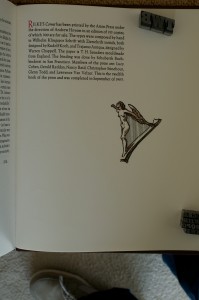 AVAILABILITY: Published in an edition of 300 in 1983, it is long out of print. Copies occasionally come up on the 2nd-hand market, where I obtained mine in fine condition at a reasonable uplift over the original $160 price. Check out the Arion Press website and/or the catalog entry for more fine press books and original info on this edition.
AVAILABILITY: Published in an edition of 300 in 1983, it is long out of print. Copies occasionally come up on the 2nd-hand market, where I obtained mine in fine condition at a reasonable uplift over the original $160 price. Check out the Arion Press website and/or the catalog entry for more fine press books and original info on this edition.

